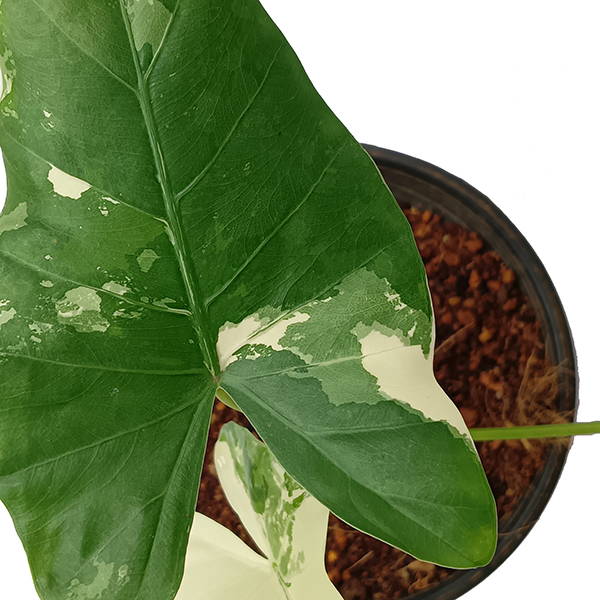
Common Name: Golden Pothos, Money Plant, Devil’s Ivy, Devil’s Vine, Silver Vine, Taro Vine, Silver Pothos (See below for available varieties)
Botanical Name: Epipremnum species, Scindapsus species, Family: Araceae
If you are a beginner who loves beautiful plants but are afraid of commitment, this lush, leafy tropical evergreen is perfect. There is a vast choice of patterned, vibrant, fast-growing varieties that will undoubtedly allure you, but its placement at the top of the easy-care plant list will make you fall in love. They also help clean — the air, that is! Two different genera are commonly called pothos; epipremnum and scindapsus. They have similar care requirements. We will cover both here. These indoor vines have unbelievable resilience and the ability to grow where many houseplants cannot, like in darker corners of your home or office. Train them to clamor up trellises and poles or can be left to dangle over the edges of tables, shelves, and countertops. Pothos are not only easy-care plants, but they are so lovely to admire.
Light
Pothos prefers medium to bright indirect sunlight, but can live in lower light conditions. However, the leaves will be smaller and the vines will become leggy if the light is not bright enough. Scindapsus and epipremnum will keep their vibrant colors and variegation defined if they receive more than 4 hours of indirect sunlight each day. If your space is light-challenged, try using LED (light emitting diode) lights as a supplement light source. Avoid setting pothos in the direct rays of the sun as their leaves will burn! Soft morning sunlight is alright, but only for a few hours.
Water
Water the soil thoroughly after the soil is almost completely dry. When the leaves start wilting, it is the best time to water it. Water more often in the growing season and reduce the frequency during the winter months. If the soil becomes compacted then soak the entire root system (root ball) in a bucket of water for 10 minutes to help loosen up the soil. A great way to test the soil for dryness its to pick up the plant and if it feels very light, then it is most likely time to water it!
Soil
All pothos love loose, nutrient-rich potting soil. Use a soil medium that can retain moisture but also allows for draining excess water to avoid root rot. Most pre-mixed soils will suffice. Make sure that there is plenty of organic matter, like coco-coir, peat moss, or shredded leaves, and avoid soils that contain moisture retaining crystals. If your soil drains too quickly, we recommend re-potting your pothos into a compost-rich soil mixture, with less drainage materials. Learn how to create your own universal soil mixture for all of your indoor plants!
Temperature
Most average household temperatures ranges will be adequate for these indoor vines. However, if they remain in temperatures under 55℉, the cold air will stunt their growth. Prolonged exposure to cold temperatures can be fatal to these tropical indoor plants. Ideal temperatures for epipremnum and scindapsus are between 65-80°F. The warmer the temperature the quicker the soil will dry out, so keep this in mind. It is also a good idea to make sure that there is good air circulation as stagnant air can cause fungal problems and invite pests to make a home on your pothos!
Humidity
As with most tropical indoor plants, pothos will benefit from higher humidity, but will do fine in average household air. Learn how to increase the humidity for your houseplants!
Fertilizer
This genus of plants highly benefits from regular fertilizing. Use a weak solution of a complete liquid fertilizer every two weeks throughout the growing season. Do not fertilize during the winter months. Sometimes your indoor plants will grow all year long. If this is the case, fertilize them during this time with a ¼-strength diluted liquid fertilizer, or top dress the soil with worm castings or a nutrient-rich compost.
Growth Rate
These indoor plants are fast growing vines reaching over 10’+ with proper care. If you provide them with a plant support, or stake they will gradually attach themselves to the support with their aerial roots!
Pro Tips
To encourage the foliage to become fuller, trim back the foliage.
Plant a few smaller plants into one larger pot to create a very full plant.
Encourage your pothos to climb on unexpected structures like staircases and ladders.
Rotate your pothos ¼-turn once a week to keep a balanced, full figure.
Trim back leggy vines to force new growth in the spring and summer.
Place the pruning cuttings from your scindapsus, or epipremnum in water as they will develop roots and plant into soil once the roots reach 2″ long!






